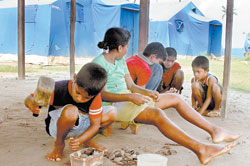| Plus |
|
|||
|
New Year still in a tent
Brightly painted boats tied to coconut trees, houses being rebuilt brick by brick…….and human efforts to keep the might of the sea at bay by building breakwaters of black rocks. Slowly and surely, the physical devastation of the tsunami is being erased. But suddenly one comes upon a blue tent settlement sloping up an incline in Maha Modera, just before arriving in Galle town, on the left of Galle Road, overlooking the sea. Where earlier there had been nearly a hundred, now are left about 15-20. In a cadjan-thatched, all sides open hut, a circle of children, girls and boys, sit around playing with areca nuts. An old man seated in a plastic chair nods off to sleep and a woman leaning on a pole that holds up the roof watches the road like a hawk. “Apita thama geval ne,” she says, explaining that they have still not got houses. They are the anu pavul – the extended families – that have been living on the beach across Galle Road, who were given the tents after the tsunami struck. As explanation she says their original homes were comparatively large, but the houses their parents have now got inland in Piyadigama are small. “They have only two rooms, so all the children who are married and have families of their own find it difficult to live with them,” says Monica Weerakkody, 36, mother of a four plus boy. Her husband is a labourer, working as an ath udaw karaya at construction sites. Then S. Uchithra, 30, saunters up from her tent close by. Before the tsunami she was living at a slightly higher economic level than the labourers and fishermen who lived in this coastal village, for she was the owner of a re kade (boutique that opened only in the night) which sold not only rice and curry but also koththu. During the day she had to engage in motherly tasks what with two girls, aged 11 and 13 and no husband. “I divorced my husband sometime ago,” she says explaining that the tsunami affected them badly. “The tsunami destroyed my kade and what was left was stolen by looters,” she says. A litany of complaints also follows, with whoever is passing by being called to support their case -- the dry rations come only once in about two to three months. The flour is rotten. There were gullas (weevils) and also worms in the flour. “We threw it for the cattle to eat. Cora buth kanna be. Me sere num honda haalak labuna,” says Monica. (The Cora rice they got cannot be eaten but this time they got some good rice.) It is noon and they discuss among themselves who will be attending a meeting with the Divisional Secretary scheduled for that afternoon to discuss their future, particularly the homes they are hoping for. As we contemplate their future, a man walks up, along with a whiff of kasippu and launches a tirade against the women. Charges and counter charges are exchanged, interspersed with choice invective. They tell him to leave in no uncertain terms, sheepishly conceding that some of the people living in the tents have houses of their own or have not been affected by the tsunami at all. We leave them with the verbal brawl hotting up as to who is entitled to what. |
||||
Copyright © 2001 Wijeya Newspapers
Ltd. All rights reserved. |
